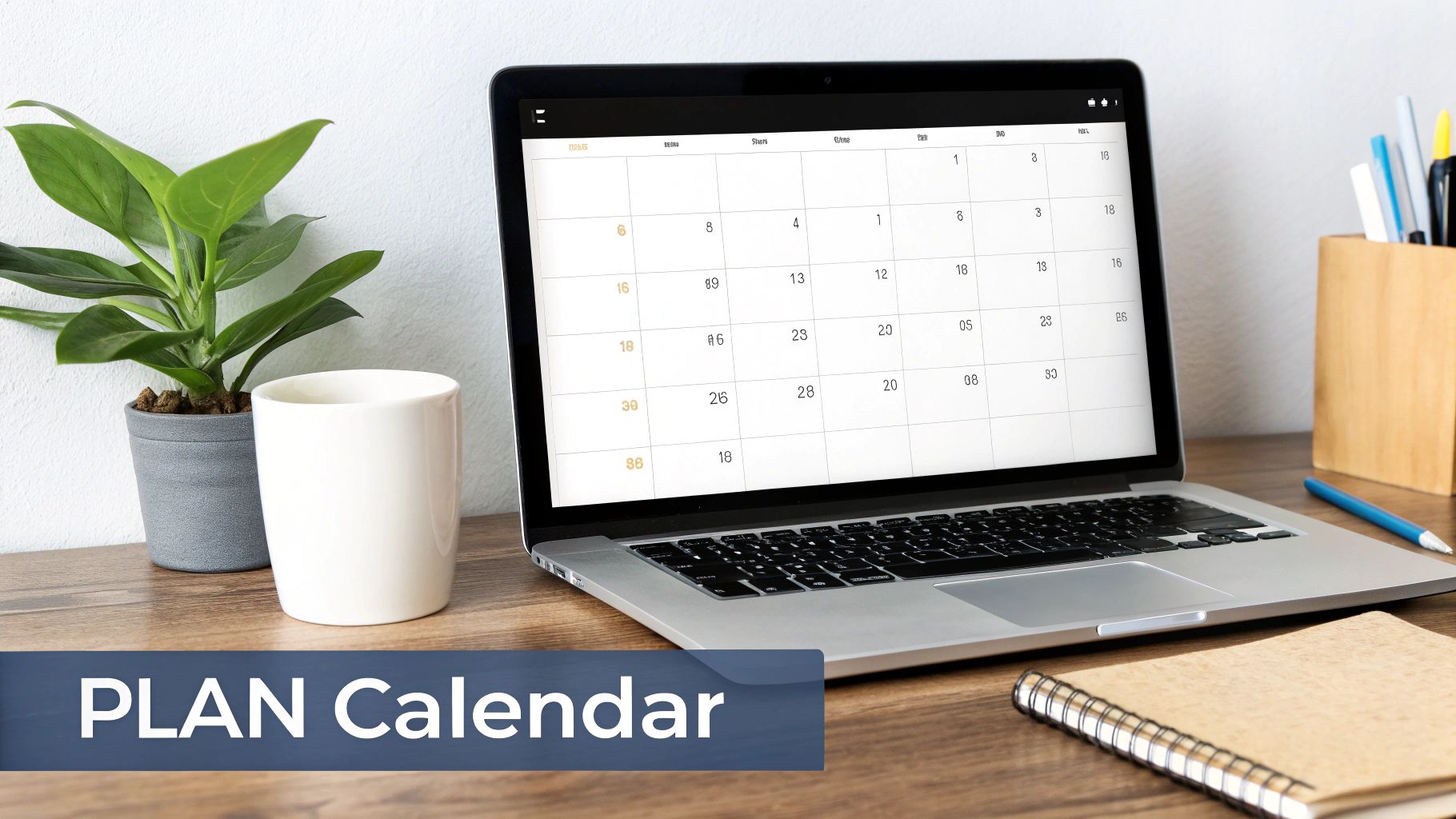Navigating Today's Social Media Content Landscape
Social media content planning has become essential for businesses. It's no longer a "nice-to-have," but a core business function. Platform algorithms prioritize strategic content, making sporadic posting less effective. This means planning is the key to thriving on social media, not just surviving.
Understanding the Shift in User Behavior
This shift is driven by the sheer volume of content competing for attention. In 2022, there were over 4.62 billion social media users globally, and that number continues to grow. This crowded space requires businesses to connect with customers more deeply and establish a unique brand identity. For a streamlined approach, consider exploring a social media scheduler comparison. This growing user base reinforces the importance of strategic social media content planning. Learn more about current trends in social media.
Adapting to the Evolving Algorithms
Algorithms reward consistent, high-quality content that resonates with target audiences. Understanding user behavior on each platform is crucial. Visual platforms like Instagram prioritize high-quality images and videos. Text-based platforms like X (formerly Twitter) favor concise, engaging writing. This means tailoring content to each platform and its users' specific expectations.
Building a Strategic Framework for Success
A robust social media content plan needs several key elements:
-
Objectives: Define clear objectives aligned with your overall business goals, such as increased brand awareness, website traffic, or lead generation.
-
Audience Research: Understand your target demographic. Research their interests, pain points, and online behavior to inform your content creation.
-
Content Calendar: Organize and schedule your posts. A well-structured calendar ensures consistency and helps maintain a cohesive brand presence across platforms. It keeps your social media efforts on track.
Measuring and Refining Your Approach
Ongoing evaluation is essential. Regularly analyze your content performance metrics, including engagement rates, reach, and website clicks. Use these insights to identify what's working and what needs improvement. This iterative process allows you to continuously optimize your strategy for better results. Adapting to the changing social media landscape and focusing on strategic planning will help your brand stand out and achieve its goals.
Crafting a Social Media Content Framework That Delivers
Stop drowning in content chaos. A well-defined social media content framework brings order to your social media presence without stifling creativity. This section explores how successful brands build these frameworks, enabling them to connect with their audience and achieve their marketing objectives.
Establishing Your Content Pillars
Think of your content pillars as the cornerstone of your social media strategy. These are the core themes or topics that consistently guide your content creation. They act as a roadmap, providing direction while still allowing flexibility for timely, reactive posts. For example, a fitness brand might establish pillars like "workout routines," "nutrition tips," and "motivational stories." This gives their audience a clear understanding of the value they offer and creates a consistent brand experience.
Aligning Your Content Calendar with Business Objectives
Your content calendar should be more than just a schedule of posts; it's a strategic tool directly tied to your business goals. Instead of focusing on vanity metrics like likes or followers, align your content with measurable outcomes. These could include driving traffic to your website, generating leads, or boosting sales. For instance, if your objective is to increase website traffic, your content calendar should include posts with clear calls to action directing users to your site.
Balancing Planned and Spontaneous Content
While planning is essential, don't be afraid to embrace spontaneity. A rigid content calendar can cause you to miss opportunities for timely engagement. The key is finding a balance. Allocate a portion of your calendar for planned campaigns and reserve space for reactive posts. This approach allows you to capitalize on trending topics or current events while maintaining a consistent brand presence.
Scaling Your Content Planning
As your audience grows, so will your content needs. Efficiently scaling your social media content planning is vital for sustained success. This might involve repurposing existing content across various platforms, collaborating with other teams, or investing in content planning tools like CoSchedule. The goal is to streamline your workflow without compromising quality or creativity. Consider your content strategy like a recipe—it can be adapted and scaled up or down depending on your needs. Learn more about structuring your website content with a sitemap in our article about how to master your sitemap.
To help you build a successful content plan, let's take a look at the essential elements involved:
Essential Elements of a Content Planning Framework
This table outlines the core components every social media content plan should include, with specific examples for different organization sizes.
| Framework Element | Purpose | Implementation Example | Common Pitfalls |
|---|---|---|---|
| Content Pillars | Define core themes to maintain focus and consistency. | A travel company focuses on "destination guides," "travel tips," and "customer stories." | Choosing pillars that are too broad or too narrow, resulting in content that lacks focus or becomes repetitive. |
| Content Calendar | Schedule and organize content for maximum impact. | A monthly calendar outlines planned posts, including themes, formats, and platforms. | Over-scheduling and leaving no room for reactive content, which can limit your ability to engage with trending topics. |
| Performance Analysis | Track and measure results to optimize content strategy. | Regularly reviewing engagement metrics and website traffic to identify successful content. | Focusing solely on vanity metrics and ignoring business objectives, which can lead to ineffective content that doesn't drive results. |
| Content Repurposing | Maximize content reach and efficiency. | Adapting a blog post into a series of social media updates or an infographic. | Repurposing content without tailoring it to each platform, which can result in content that feels out of place or doesn't resonate with the audience. |
By understanding these elements and how they work together, you can create a content planning framework that supports your overall social media goals.

By implementing a robust social media content framework, you can create engaging content, achieve your business goals, and build a thriving online community. This structured approach ensures you stay organized, adapt to changes, and maximize your impact on social media.
Video Content Planning That Captivates Your Audience
Beyond the technical aspects of video production, a well-defined social media content planning strategy is essential for engaging video content. Leading brands understand the power of video and are developing strategies for platforms from TikTok to YouTube.
Platform-Specific Video Strategies
Different platforms require different approaches. Short, attention-grabbing videos using trending sounds and hashtags thrive on TikTok. On YouTube, longer, more in-depth content like tutorials or product demonstrations performs better. Understanding these nuances is crucial for successful video content planning. Think of each platform as a unique stage, each requiring a different performance.
Maintaining Visual Consistency Across Platforms
Adapting to each platform's style is important, but maintaining a consistent visual identity is equally crucial for brand recognition. This includes using consistent branding elements, like logos and color palettes, across all videos, regardless of the platform. This consistency helps viewers instantly recognize your brand, building familiarity and trust. It's like a signature style – setting you apart and reinforcing your brand message.
Building Sustainable Video Production Processes
Creating high-quality video content doesn't require a massive budget. Focus on building sustainable production processes that align with your resources. This might involve repurposing existing content, collaborating with in-house teams, or leveraging user-generated content. Smart planning and resource allocation are key to long-term success. Short-form video content has become incredibly popular, with 91% of businesses using video as a marketing tool. 33% of social media marketers in 2023 planned to invest primarily in short-form videos, reflecting a shift towards easily consumable content. Find more statistics here.
Data-Driven Optimization

Successful brands analyze their video performance data to inform future content. This involves tracking key metrics such as watch time, engagement, and audience retention. By understanding what resonates with their audience, brands can refine their video strategy and create more compelling content. It's about continuous improvement, using data as your guide. This data-driven approach allows brands to adjust their strategies based on actual results, not assumptions. By understanding what truly resonates, they can create video content that captivates, informs, and drives results.
Creating Content That People Actually Want to Engage With
Social media content planning isn't just about scheduling posts. It's about understanding what truly resonates with your audience. It's about moving beyond generic advice and diving into the psychology of engagement. By analyzing high-performing content, we can discover what triggers meaningful interactions, turning passive scrollers into active participants.

Understanding the Psychology of Engagement
Why do some posts spark conversations while others are ignored? It comes down to understanding the human element. People engage with content that evokes emotion, provides value, or creates a sense of community. This could be a funny post that makes someone laugh, an informative article that teaches them something new, or a user-generated photo that makes them feel like they belong. Think of your content as a conversation starter. What questions can you ask? What stories can you share? What value can you offer that will truly connect with your audience?
Balancing Promotional Content with Value-Driven Posts
Promoting your products or services is essential, but constantly pushing sales messages can quickly alienate your audience. The key is striking the right balance between promotional content and content that provides genuine value. This balance will vary depending on your platform and your specific audience. For example, a business-to-business (B2B) company on LinkedIn might lean towards more informative content, while a fashion brand on Instagram might focus more on visually-driven lifestyle posts. Consider the 80/20 rule: 80% of your content should provide value, while 20% can be promotional. This builds trust and positions your brand as a valuable resource, making your audience more receptive to your promotional messages when they do appear.
Incorporating User-Generated Content (UGC)
User-generated content (UGC) is a powerful tool for building community and reducing production demands. Featuring content created by your audience showcases real people engaging with your products or services, making your followers feel seen and valued. This fosters authenticity and strengthens the connection between your brand and your audience. Leading brands actively incorporate UGC into their social media content planning, often using contests or campaigns that encourage users to share their experiences. This organic content often resonates more than professionally produced material because it feels more relatable and genuine. You might be interested in: How to master sitemaps and organize your content.
Implementing Systematic Content Testing
Successful brands don't just randomly experiment with different content formats. They use a systematic approach to testing. This involves setting clear objectives for each piece of content, tracking key metrics like engagement and reach, and then analyzing the results to understand what works best. This data-driven approach allows for continuous improvement, ensuring your social media content planning stays aligned with your audience’s preferences and your business goals. Think of it like a scientific experiment; by testing different variables, you can identify the formula for the best results.
To help illustrate these concepts, let's look at how various platforms perform:
Introduction to the table: The following table provides a general overview of content performance metrics across popular social media platforms. This information can be helpful as a starting point for your own content planning and testing.
| Platform | Avg. Engagement Rate | Optimal Posting Frequency | Top-Performing Content Types |
|---|---|---|---|
| 0.5% – 1% | 1-2 posts per day | Videos, images, live streams | |
| 1% – 3% | 1-3 posts per day | High-quality images, stories, reels | |
| 0.3% – 0.5% | 3-5 tweets per day | News, opinions, engaging questions | |
| 1% – 2% | 1-2 posts per day | Articles, industry news, job postings | |
| TikTok | 5% – 10% | 1-4 videos per day | Short-form videos, trending challenges |
Key takeaway from the table: As shown in the table, engagement rates and optimal posting frequencies vary significantly across different platforms. Understanding these differences is crucial for tailoring your content strategy to each specific platform.
By understanding the psychology of engagement, balancing promotional messages with valuable content, leveraging UGC, and implementing systematic content testing, you can create social media content that resonates with your target audience, builds community, and drives business results. This strategic approach ensures you're not just posting content – you're building meaningful connections that foster long-term growth.
Merging Paid and Organic in Your Content Planning

Planning your social media content requires a smart mix of organic reach and paid promotion. These two strategies shouldn't be isolated; they should complement each other to maximize your results. Leading brands are increasingly integrating paid and organic efforts, providing a consistent experience for their audience. A truly effective strategy considers both sides of content distribution.
Identifying Content for Paid Amplification
Not all content is the same. Some pieces naturally gain organic traction, while others greatly benefit from paid promotion. So, how do you decide which content to boost? Consider these factors:
-
High-Performing Organic Content: If content is already performing well organically, it’s an excellent choice for paid amplification. This expands your reach and extends the lifespan of your top posts. For instance, a blog post driving substantial website traffic can be promoted to reach an even wider audience.
-
Content Targeting Specific Business Objectives: Your paid content should directly support your overall business goals. If you’re launching a new product, paid campaigns can build targeted awareness. If driving sales is your focus, paid ads can promote specific offers or discounts.
-
Content Designed for Multi-Touch Conversion Journeys: Consumers rarely convert on their first interaction. Paid content plays a key role in nurturing leads through the sales funnel. Retargeting ads, for example, can re-engage users who have previously shown interest in your products or services. You might find this helpful: How to master job listings with a sitemap.
Adapting Organic Content for Paid Distribution
Creating separate content for paid and organic campaigns is inefficient. Instead, adapt existing organic content for paid use. This could involve small adjustments to format, length, or the call to action. For example, a popular Instagram post can easily become a short video ad for Facebook or Instagram Stories. Social media advertising is essential for content strategies. In 2022, it comprised approximately 33% of global digital ad spending, emphasizing social media’s role in brand visibility and sales. You can find more statistics here.
Budgeting for Paid Social Media
Smart budget allocation is critical for maximizing ROI on your paid campaigns. Don't rely on arbitrary numbers; base your budget on specific business objectives and projected returns. For example, if your goal is generating a certain number of leads, your budget should reflect the cost per lead and your desired lead volume. This approach ensures that your paid efforts directly contribute to your bottom line.
Measuring True ROI
Measuring the combined success of your paid and organic strategy requires looking beyond surface-level engagement metrics. While likes and shares offer some insights, focus on metrics aligned with your business objectives. These might include website conversions, lead generation, or sales revenue. This comprehensive approach provides a clear picture of the real impact of your social media content planning. By integrating paid and organic strategies, accurately measuring ROI, and continually optimizing, you can build a robust social media presence that delivers tangible results.
Tools That Actually Improve Your Content Planning
Picking the right tools for social media content planning can seriously boost your team's efficiency. But the sheer volume of platforms out there can be overwhelming. This section helps you cut through the clutter, zeroing in on solutions that truly enhance your workflow.
Identifying Your Team's Needs
Before diving into specific tools, take stock of your team's structure, how much content you produce, and your collaborative needs. A small team creating less content might only need a simple scheduling tool. Larger teams with more complex workflows, on the other hand, will benefit from platforms with collaborative features, approval processes, and analytics dashboards. Think of your workflow as a recipe: the tools are your appliances. Choose ones that complement your ingredients, not complicate them.
Essential Features to Look For
Effective social media content planning tools offer a few key features:
-
Content Scheduling and Publishing: This core function lets you plan and schedule posts across different platforms in advance. This automation frees up valuable time and maintains a consistent content flow.
-
Collaboration and Workflow Management: Tools with built-in collaboration streamline communication and make your team more efficient. Features like assigning tasks, tracking progress, and sharing feedback within the platform are invaluable.
-
Analytics and Reporting: Tracking your content's performance is essential for a winning strategy. Choose tools that give you solid analytics on engagement, reach, and other important metrics.
-
Content Curation and Inspiration: Some platforms help you curate relevant content from the web, sparking ideas for your own content creation.
Comparing Popular Content Planning Tools
This table compares some popular tools and their key features:
| Tool | Scheduling & Publishing | Collaboration | Analytics | Content Curation |
|---|---|---|---|---|
| Hootsuite | Yes | Yes | Yes | Yes |
| SproutSocial | Yes | Yes | Yes | Yes |
| Buffer | Yes | Yes | Yes | Limited |
| Later | Yes | Yes | Yes | No |
This table is a starting point. Do your research and consider your team's unique needs before choosing. Remember, even the best tools are ineffective without proper implementation and integration into your existing workflow.
Building an Integrated Workflow
The goal is a streamlined workflow that fuels creativity, not stifles it. Avoid too many separate tools; they can create unnecessary complexity. Instead, focus on a few key platforms that work well together and provide a complete solution for your social media content planning. Think of it like assembling a puzzle: the right pieces fit together smoothly to create a clear, effective picture.
Successful brands build approval processes that maintain quality without slowing things down. This means clearly defined roles and responsibilities, open communication channels, and tools that make review and approval easy. This structured approach ensures content is carefully checked before it's published, while keeping the process efficient.
Through effective social media content planning, you can create engaging campaigns, build a strong online presence, and achieve your business goals. By carefully selecting and integrating the right tools, you empower your team to work efficiently, collaborate effectively, and maximize their content’s impact.
Ready to bring your creative vision to life? Visit Creativize and discover local talent ready to help with your projects. Connect with skilled professionals specializing in branding, 2D animation, and a range of other creative services. Find the perfect fit for your needs and elevate your brand with fresh, dynamic expertise.

